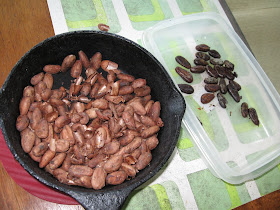
I'm roasting cacao for granola bars. It's a fun job, the hard stone sound of dried bean against cast iron skillet, the growing scent of chocolate and the sudden pop as the first bean splits its shell. Then I can take them off the heat and wait until they are cool enough to handle before I shell them. Cacao is much easier to shell while it's still hot.
The botanical name for the cacao tree is theobroma cacao, Greek for food of the gods, it was revered by the native Indians as a food of the gods. The story goes that the first cacao tree grew from the dead body of Sura, the co-creator god of south and central america. It was used ceremoniously, as medicine and as money. Is this where the expression ‘money grows on trees’ comes from? In the Mayan culture a porter earned 100 cacao beans a day: the price of a hare; an avocado cost one bean; a fish wrapped in a corn husk cost 3. It was taken or exchanged during both religious and civic ceremonies, for example at a wedding the bride and groom exchanged 5 beans.
The trees look a little like apple trees, fairly short and gnarled. The pods grow from the stems and trunk and are shaped like a rugby ball but ridged and knobbly, they vary in colour from a minty green to a deep dark maroon. Inside the beans hang from a sinewy tough central stem – a bit like the middle of a tangerine but much stronger. The beans are covered with thick white ooze which tastes sweet but makes the whole thing look like the innards of some alien. The beans are almond shaped and sized, but smooth, they’re a creamy coffee colour, inside they are the most royal bright purple. The whole pod from inside out is an experience of colour and texture, shelling the beans has to be a fairly ritualistic practice moving through hard to soft to hard, ridged to slippery to smooth surfaces. The beans taste bitter but they come with a kick: 5 roughly equal an espresso shot. And they are rich. I’ve heard of people eating 30 and getting high, seeing the cacao god himself!
It’s said that cacao is a superfood: very rich in antioxidants, potassium, magnesium, dopamine, seratonin, anandamide, tryptophan and phenylethylamines are amongst the 300 chemical compounds present in cacao. With the seratonin, anandamide, dopamine and phenylethylamine it’s no wonder chocolate lifts one’s mood and why so many people reach for a slab when all else seems to fail. Of course the most healthy way to absorb all this goodness is through the fresh or dried bean, but that’s not so practical. They say that the addition of dairy products blocks the absorption of much of the benefits, so the darker the chocolate - and the least processed - the better for you.
This farm was a cacao plantation until the blight came. There are many trees left and we still harvest a good amount, enough to sell at the farmers' market and use in our bars and cookies. The harvesting is fun too: remove the beans and their white goop and throw in a gunny sack which gets hung undercover for 5 to 6 days. The beans ferment during this time and the white goop attracts the bugs and bacteria necessary for the fermentation. After the fermentation the beans are sun dried for maybe another 3 to 5 days and are then stored until needed. The major cacao traders and chocolate companies trade in these dried beans and the bigger chocolate producers have on average a 2 year supply of these dried beans. In Costa Rica cacao is at its highest price in years, but at barely $2 per kilo of organic dried beans, it's not really viable as a cash crop. Most cacao now comes from west african countries - hence the two year store as these countries are not so stable.
Back to my delicious task!
After you shell the cacao, how would the beans become chocolate?
ReplyDeleteHi Trish,
ReplyDeleteThere are several ways, but all begin with grounding the roasted beans into a paste, then adding sweeteners and sometimes flavourings. We do it 2 ways here on the farm:
- mix the paste with a little coconut milk and cook over low/medium heat stirring until most of the liquid has evaporated, then add more coconut milk and repeat. Add some sugar to taste. The idea is to keep adding the milk until you get to a consistency you like but keep it as dry as possible. It's very simple but hard to describe. Best seen.
- over heat mix cacao paste with dark sugar to taste. If desired, add nutmeg, cinnamon, ginger, lime peel, orange peel, black pepper, or vanilla. Nutmeg and black pepper are my favourites.
With both methods, allow to cool a little, roll into sausages, cut and put in the fridge / freezer to firm up. Wrap in wax paper.
The more 'western' method is to add the cacao paste to sugar and put it in a conching machine for at least 24 hours. This produces that smooth chocolate we're used to buying elsewhere. The two methods above will produce a thick, grainy, dark, quite heavy chocolate. But it's very real and fresh and rich and excellent! Thanks for asking,
Ancel